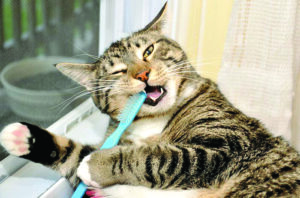By Dr. Beth Leermakers
When was the last time you brushed your cat’s teeth? If you’re like many cat parents, the answer is “never.”

Photo courtesy of 1Funny.com
Feline dental care is important to prevent dental disease and other health problems. Periodontal disease is the number one medical condition diagnosed in cats — more than weight problems, kidney disease or other common feline health issues. According to the American Veterinary Dental Society, 70 percent of cats have some form of dental disease by the time they’re 3 years old. Periodontal disease starts as a buildup of plaque and tartar on the teeth. Throughout time, the plaque spreads below the gumline, leading to inflammation, infected gums and eventually tooth loss. Periodontitis has been linked to heart disease, kidney disease and other chronic illnesses. Once gums become infected, bacteria from the mouth can enter the bloodstream and travel to other organs, such as the heart, liver and kidneys, where they cause added health problems for your cat.
Bad breath (halitosis) is a good indicator that your cat may have some form of dental disease. If your cat has bad breath and is drooling, the cause is often related to gum disease and tooth decay. Bad breath may also be the result of diabetes or kidney disease, so it’s important to mention it to your veterinarian. If your cat has also experienced changes in appetite, difficulty swallowing, vomiting or diarrhea, visit your vet as soon as possible. Your cat may have a serious underlying condition that needs prompt attention.
To prevent dental disease, provide home dental care (including regular teeth brushing) and take her for a professional dental cleaning once a year.
How to Brush Your Cat’s Teeth
Get your cat used to the process. Your cat probably won’t let you put a toothbrush in her mouth and start brushing right away — especially if she’s an adult. You may need to spend several weeks getting your cat to tolerate this activity. Start by using your fingers to massage your cat’s lips in slow, circular motions for up to one minute, once or twice a day. Then, when she’s comfortable with that, massage her teeth and gums using the same motion. If possible, start when your cat is young and may be more cooperative.
The next step is to place a pea-sized amount of pet toothpaste (such as Vetoquinol poultry-flavored toothpaste) on your finger. Let your cat taste it, and then immediately give her a treat. Do NOT use human toothpaste; ingesting fluoride toothpaste can make your cat extremely ill. During the next few days, increase the amount of time between your cat eating the toothpaste and getting a treat. Then put a small amount of toothpaste on the pet toothbrush (smaller than a human one, with softer bristles). You can use square gauze or cotton swabs instead of a cat toothbrush. Let your cat lick the toothbrush, and then give her a treat. Repeat this process for several days, increasing the time between licking and getting a treat.
Brush your cat’s teeth using small, circular motions. Lift her lip and clean the outside of her teeth and gumline. Make the circular motions smooth and quick, and talk to your cat as you brush. Take a break every 5-10 seconds and give her some positive attention, such as petting or talking to her. Brushing your cat’s teeth should take 30- 60 seconds. Brush your cat’s teeth every day to prevent serious dental disease.
If your cat won’t let you brush her teeth, you can use a food and water dental additive or dental chew. Ask your vet which tooth-brushing alternative to use. Look for cat dental care products that have the Veterinary Oral Health Council (VOHC) seal of approval, indicating that they have gone through clinical trials and met a standard of effectiveness. Certified by the VOHC, Feline Greenies Dental Treats Catnip Flavor have a crunchy texture designed to reduce tartar buildup.
Professional Dental Cleaning
Veterinarians recommend you schedule an annual dental cleaning for your cat. If your cat has dental tartar, gingivitis or periodontitis, a professional cleaning is the only way to get rid of it. Prevention (through regular cleanings starting when your cat is young) is the cheaper, less painful way to go!
To safely and thoroughly examine and clean your cat’s teeth, your vet needs to use general anesthesia. According to the 2019 AAHA Dental Care Guidelines for Dogs and Cats, vets should perform these procedures before, during and after dental cleanings, surgeries and procedures: examine the conscious pet’s mouth before administering anesthesia; X-ray the entire mouth of the anesthetized patient to determine whether deeper structures, like the roots of teeth, are healthy; remove plaque and tartar above and below the gums; polish the teeth to smooth the enamel, inhibiting reformation of plaque and tartar; use a periodontal probe to look for deep pockets between the teeth and gums that require treatment; flush out those pockets to remove debris; perform root canals or extractions if needed; administer either systemic or local antibiotics where indicated; apply antiplaque substances such as barrier sealants to the teeth; biopsy all abnormal masses and submit them to a qualified pathologist; educate the owner about at-home dental care, including the use of safe cat dental products.
Following these two easier-said-than-done steps will help keep your cat healthy and pain-free.
Isn’t that worth the effort?
